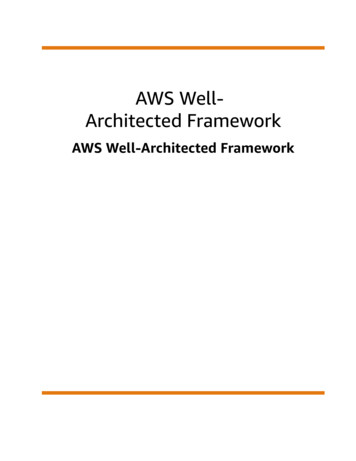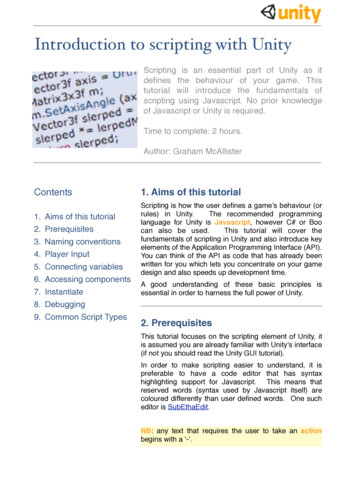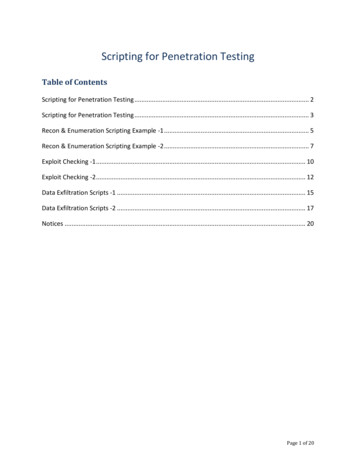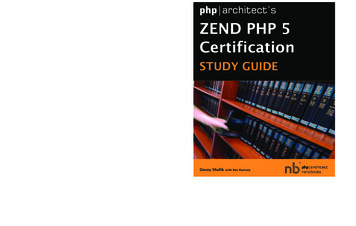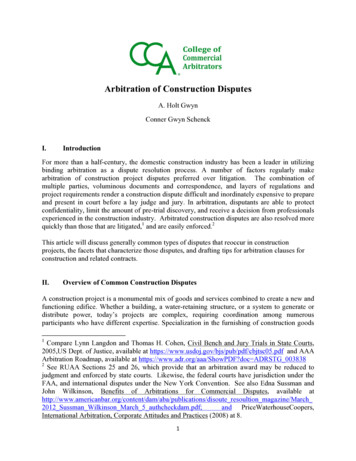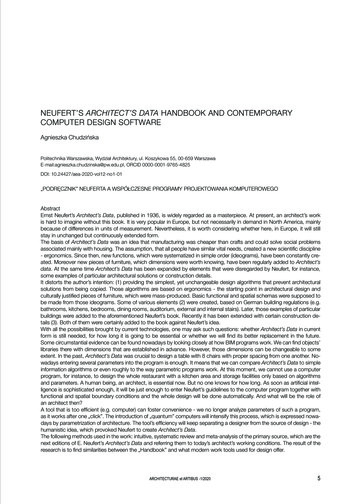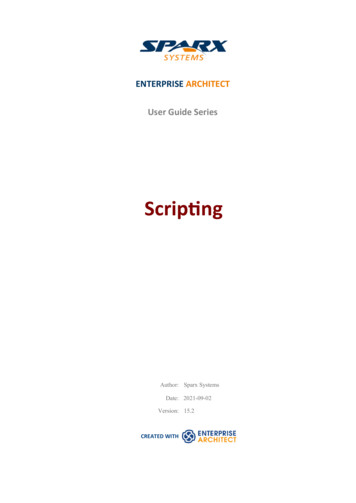
Transcription
ENTERPRISE ARCHITECTUser Guide SeriesScriptingAuthor: Sparx SystemsDate: 2021-09-02Version: 15.2CREATED WITH
Table of ContentsScriptingJavaScript Math LibraryArithmetic and Algebraicsqrtlsqrtcbrtpolevl, rpolmovExponential and 53637383940414243444546474849505152535455
sindgtantandgExponential cbetincbiigamigamcigamipsirgammaError 01102103104105106107108109111112113
ymvmpymtranspeigensNumerical IntegrationsimpsnComplex ArithmeticcaddcsubcmulcdivcabscsqrtComplex Exponential and 70172174176177179180
clogccoscacoscsincasinctancatanccoterrorsSolvers InterfaceScripts TabConsole TabJavaScript ConsoleScript Group PropertiesScript EditorSession ObjectScript 7199202203
Scripting2 September, 2021ScriptingEnterprise Architect's scripting environment is a flexible and easy to use facility that supports both JavaScript and theMicrosoft scripting languages JScript and VBScript. When any script runs, it has access to a built-in 'Repository' object.Using this script object you can programmatically inspect and/or modify elements within your currently open model.Enterprise Architect also provides feature rich editors, and tools to run, debug and manage your scripts. Scripts aremodular and can include other scripts by name using the !include directive. They can be used for a broad range ofpurposes, from documentation to validation and refactoring, and they can be of enormous help with automating timeconsuming tasks.Script Engine Support·Mozilla SpiderMonkey [ version 1.8 ]·Microsoft Scripting EngineScript ··Inspecting and reporting on model and element composition··Modifying diagram layouts···Creating and implementing process workflows·Automation Server role for in-process and out-of-process COM clients (Scripting is itself an example of anin-process client; Add-Ins are another)·Element access governance through Workflow security·Model Search integrationModifying and updating element propertiesRunning queries to obtain extended model informationBeing called from report document templates to populate reportsBeing included in MDG Technologies to augment domain specific languagesExtensive UI access to scripts through context menus(c) Sparx Systems 2021Page 6 of 204Created with Enterprise Architect
Scripting2 September, 2021Script GroupsScripts are managed and contained in groups. Each group has an attribute called 'Type'. This attribute is used to helpEnterprise Architect decide how and where the script can be used and from which features it should be made available.The properties of a script group can be viewed from its shortcut menu.Script StorageBuilt in scripts are file based and are installed with Enterprise Architect. They appear under the Local Scripts group.You cannot edit or delete Local scripts, but you can copy the contents easily enough.User defined scripts are model based and as such, can be shared by a community. They are listed in the group to whichthey belong.Using ScriptsThe management interface for Scripting is the Scripting window, which contains the:··Script Tree View ('Scripts' tab), which you use to review, create and edit scriptsScript Console ('Console' tab), which you use to operate on an executing scriptOther than the Local Scripts, which are file based and installed with Enterprise Architect, all other scripts are stored asmodel assets and can be shared with all users of the model. Script debuggers can help you with script development andscript editors can provide you with information on the automation interfaces available to you. Analyze the execution, forexample by recording a Sequence diagram of the script execution and halting execution to view local variables.Using SolversAnywhere in Enterprise Architect that has JavaScript code, such as in Simulation, you can now use a JavaScriptconstruct called 'Solver' (the Solver Class) to integrate with external tools and have direct use of the functionality withineach tool to simply and intuitively perform complex maths and charting functions. The calls help you to easilyinterchange variables between the built in JavaScript engine and each environment. Two Math Libraries that aresupported are MATLAB and Octave.To use the Solver Class, you need to have a knowledge of the functions available in your preferred Math Library and theparameters they use, as described in the product documentation.Being part of the JavaScript engine, Solver Classes are also immediately accessible to Add-In writers creating modelbased JavaScript Add-Ins.Also see the Octave Solver, MATLAB Solver and Solvers Help topics.(c) Sparx Systems 2021Page 7 of 204Created with Enterprise Architect
Scripting2 September, 2021Notes·This facility is available in the Corporate, Unified and Ultimate Editions·If you intend to use the Scripting facility under Crossover/WINE, you must also install Internet Explorer version 6.0or above(c) Sparx Systems 2021Page 8 of 204Created with Enterprise Architect
Scripting2 September, 2021JavaScript Math LibraryThe legendary Cephes Math Library is fully and tightly integrated with the JavaScript engine available within EnterpriseArchitect. This library is a collection of more than 400 high-quality mathematical routines for scientific and engineeringapplications, providing a huge range of mathematical potential for modelers wanting to take their engineering andsystems models to the next level.The function library implements the IEEE Std 754 double-precision standard.···············Arithmetic and AlgebraicExponential and TrigonometricExponential integralGammaError cellaneousMatrixNumerical IntegrationComplex ArithmeticComplex Exponential and Trigonometricerrors(c) Sparx Systems 2021Page 9 of 204Created with Enterprise Architect
Scripting2 September, 2021Arithmetic and �·sqrt- square rootlsqrt- integer square rootcbrt- cube rootpolevl, p1evl - evaluate polynomialchbevl - evaluate Chebyshev seriesround - round to nearest integer valueceil- truncate upward to integerfloor- truncate downward to integerfrexp - extract exponentldexpfabs- add integer to exponent- absolute valuesignbit - return sign bit as intisnan- number testisfinite - finite testpoladd - add polynomialspolsub - subtract polynomialspolmul - multiply polynomialspoldiv - divide polynomialspolsbt - substitute polynomial variablepoleva - evaluate polynomialpolclr - set all coefficients to zeropolmov - copy coefficients(c) Sparx Systems 2021Page 10 of 204Created with Enterprise Architect
Scripting2 September, 2021sqrtSquare root.SYNOPSIS:double x, y, sqrt();y sqrt(x);DESCRIPTION:Returns the square root of x.Range reduction involves isolating the power of two of the argument and using a polynomial approximation to obtain arough value for the square root. Then Heron's iteration is used three times to converge to an accurate value.ACCURACY:Relative error:arithmetic domain# trialsDEC0, 1060000IEEE0,1.7e308 30000peak2.1e-171.7e-16rms7.9e-186.3e-17ERROR MESSAGES:messagedomainconditionx 0(c) Sparx Systems 2021value returned0.0Page 11 of 204Created with Enterprise Architect
Scripting2 September, 2021lsqrtInteger square root.SYNOPSIS:long x, y;long lsqrt();y lsqrt(x);DESCRIPTION:Returns a long integer square root of the long integer argument. The computation is by binary long division. The largestpossible result is lsqrt(2,147,483,647) 46341.If x 0, the square root of x is returned, and an error message is available.ACCURACY:An extra, roundoff, bit is computed; hence the result is the nearest integer to the actual square root.(c) Sparx Systems 2021Page 12 of 204Created with Enterprise Architect
Scripting2 September, 2021cbrtCube root.SYNOPSIS:double x, y, cbrt();y cbrt(x);DESCRIPTION:Returns the cube root of the argument, which could be negative. Range reduction involves determining the power of 2 ofthe argument. A polynomial of degree 2 applied to the mantissa, and multiplication by the cube root of 1, 2, or 4approximates the root to within about 0.1%. Then Newton's iteration is used three times to converge to an accurate result.ACCURACY:Relative error:arithmetic domain# 308300001.5e-165.0e-17JavaScript:////Plot of y 3vx.//function plotYforX(x1, x2){for(var x x1; x x2; x ){var y cephes.cbrt(x);Session.Output("plot of x for " x " gives y of " y);}}function main(){plotYforX(-1,6);}main();(c) Sparx Systems 2021Page 13 of 204Created with Enterprise Architect
Scripting2 September, 2021polevl, p1evlEvaluate polynomial.SYNOPSIS:int N;double x, y, coef[N 1], polevl[];y polevl(x, coef, N);DESCRIPTION:Evaluates polynomial of degree N:2Ny C C x C x . C x0 12NCoefficients are stored in reverse order:coef[0] C , ., coef[N] C .N0The function p1evl() assumes that coef[N] 1.0 and is omitted from the array. Its calling arguments are otherwise thesame as polevl().SPEED:In the interest of speed, there are no checks for out of bounds arithmetic. This routine is used by most of the functions inthe library. Depending on available equipment features, the user might want to rewrite the program in microcode orassembly language.JavaScript:Example:function stirlingFormula(x){var STIR [ 7.87311395793093628397E-4, E-3, 2 ];var SQTPI 2.50662827463100050242E0;var MAXSTIR 143.01608;var w 1.0 / x;var y cephes.exp(x);(c) Sparx Systems 2021Page 14 of 204Created with Enterprise Architect
Scripting2 September, 2021var w 1.0 w * cephes.polevl(w, STIR, 4);if (x MAXSTIR) {var v cephes.pow(x, 0.5 * x - 0.25);y v * (v / y);} else {y cephes.pow(x, x - 0.5) / y;}y SQTPI * y * w;return y;}(c) Sparx Systems 2021Page 15 of 204Created with Enterprise Architect
Scripting2 September, 2021chbevlEvaluate Chebyshev series.SYNOPSIS:int N;double x, y, coef[N], chebevl();y chbevl(x, coef, N);DESCRIPTION:Evaluates the seriesN-1-'y coef[i] T (x/2)-ii 0of Chebyshev polynomials Ti at argument x/2.Coefficients are stored in reverse order, i.e. the zero order term is last in the array. Note N is the number of coefficients,not the order.If coefficients are for the interval a to b, x must have been transformed to x - 2(2x - b - a)/(b-a) before entering theroutine. This maps x from (a, b) to (-1, 1), over which the Chebyshev polynomials are defined.If the coefficients are for the inverted interval, in which (a, b) is mapped to (1/b, 1/a), the transformation required is x - 2(2ab/x - b - a)/(b-a). If b is infinity, this becomes x - 4a/x - 1.SPEED:Taking advantage of the recurrence properties of the Chebyshev polynomials, the routine requires one more addition perloop than evaluating a nested polynomial of the same degree.JavaScript:var y cephes.chbevl(x, coef, N);(c) Sparx Systems 2021Page 16 of 204Created with Enterprise Architect
Scripting2 September, 2021roundRound double to nearest or even integer valued doubleSYNOPSIS:double x, y, round();y round(x);DESCRIPTION:Returns the nearest integer to x as a double precision floating point result. If x ends in 0.5 exactly, the nearest eveninteger is chosen.ACCURACY:If x is greater than 1/(2*MACHEP), its closest machine representation is already an integer, so rounding does not changeit.(c) Sparx Systems 2021Page 17 of 204Created with Enterprise Architect
Scripting2 September, 2021floorSYNOPSIS:double floor(x);double x,y;y floor(x);DESCRIPTION:floor() returns the largest integer less than or equal to x. It truncates toward minus infinity.(c) Sparx Systems 2021Page 18 of 204Created with Enterprise Architect
Scripting2 September, 2021ceilSYNOPSIS:double ceil(x);double x, y;y ceil(x);DESCRIPTION:ceil() returns the smallest integer greater than or equal to x. It truncates toward plus infinity.(c) Sparx Systems 2021Page 19 of 204Created with Enterprise Architect
Scripting2 September, 2021frexpExtract exponent.SYNOPSIS:double frexp(x, expnt);double x;int expnt;y frexp(x, &expnt);DESCRIPTION:frexp() extracts the exponent from x. It returns an integer power of two to expnt and the significand between 0.5 and 1 toy. Thus x y * 2**expn.(c) Sparx Systems 2021Page 20 of 204Created with Enterprise Architect
Scripting2 September, 2021ldexpSYNOPSIS:double ldexp(x,n);double x;int n;y ldexp(x, n);DESCRIPTION:ldexp() multiplies x by 2**n.(c) Sparx Systems 2021Page 21 of 204Created with Enterprise Architect
Scripting2 September, 2021fabsAbsolute value.SYNOPSIS:double x, y;y fabs(x);DESCRIPTION:Returns the absolute value of the argument.(c) Sparx Systems 2021Page 22 of 204Created with Enterprise Architect
Scripting2 September, 2021signbitSYNOPSIS:int signbit(x);double x;int n;n signbit(x);DESCRIPTION:signbit(x) returns 1 if the sign bit of x is 1, else 0.(c) Sparx Systems 2021Page 23 of 204Created with Enterprise Architect
Scripting2 September, 2021isnanSYNOPSIS:int isnan(x);double x;int n;n isnan(x);DESCRIPTION:Returns true if x is not a number.(c) Sparx Systems 2021Page 24 of 204Created with Enterprise Architect
Scripting2 September, 2021isfiniteSYNOPSIS:int isfinite();double x;int n;n isfinite(x);DESCRIPTION:Return true if x is not infinite and is not a NaN(c) Sparx Systems 2021Page 25 of 204Created with Enterprise Architect
Scripting2 September, 2021poladdPolynomial AdditionSYNOPSIS:int maxpol, na, nb, nc;double a[na], b[nb], c[nc];nc max(na, nb);polini( nc );poladd( a, na, b, nb, c );DESCRIPTION:poladd( a, na, b, nb, c ); c b a, nc max(na, nb)In the following description a, b, c are polynomials of degree na, nb, nc respectively.The degree of a polynomial cannot exceed a run-time value MAXPOL.An operation that attempts to use or generate a polynomial of higher degree may produce a result that suffers truncationat degree MAXPOL.The value of MAXPOL is set by calling the functionpolini( MAXPOL );Each polynomial is represented by an array containing its coefficients, together with a separately declared integer equalto the degree of the polynomial.The coefficients appear in ascending order; that is,2naa(x) a[0] a[1] * x a[2] * x . a[na] * x .(c) Sparx Systems 2021Page 26 of 204Created with Enterprise Architect
Scripting2 September, 2021polsubPolynomial SubtractionSYNOPSIS:int maxpol, na, nb, nc;double a[], b[], c[];nc max(na, nb);polini( nc );polsub( a, na, b, nb, c );DESCRIPTION:polsub( a, na, b, nb, c ); c b - a, nc max(na, nb)a, b, c are polynomials of degree na, nb, nc respectively.The degree of a polynomial cannot exceed a run-time value MAXPOL.An operation that attempts to use or generate a polynomial of higher degree may produce a result that suffers truncationat degree MAXPOL.The value of MAXPOL is set by calling the functionpolini( MAXPOL );Each polynomial is represented by an array containing its coefficients, together with a separately declared integer equalto the degree of the polynomial.The coefficients appear in ascending order; that is,2naa(x) a[0] a[1] * x a[2] * x . a[na] * x .(c) Sparx Systems 2021Page 27 of 204Created with Enterprise Architect
Scripting2 September, 2021polmulPolynomial MultiplicationSYNOPSIS:int maxpol, na, nb, nc;double a[], b[], c[];nc na nb;polini( nc );polmul( a, na, b, nb, c );DESCRIPTION:polmul( a, na, b, nb, c ); c b * a, nc na nba, b, c are polynomials of degree na, nb, nc respectively.The degree of a polynomial cannot exceed a run-time value MAXPOL.An operation that attempts to use or generate a polynomial of higher degree may produce a result that suffers truncationat degree MAXPOL.The value of MAXPOL is set by calling the functionpolini( MAXPOL );Each polynomial is represented by an array containing its coefficients, together with a separately declared integer equalto the degree of the polynomial.The coefficients appear in ascending order; that is,2naa(x) a[0] a[1] * x a[2] * x . a[na] * x .(c) Sparx Systems 2021Page 28 of 204Created with Enterprise Architect
Scripting2 September, 2021poldivPolynomial DivisionSYNOPSIS:int maxpol, na, nb, nc;double a[], b[], c[];nc na nbpolini( MAXPOL );i poldiv( a, na, b, nb, c );DESCRIPTION:i poldiv( a, na, b, nb, c ); c b / a, nc MAXPOLreturns i the degree of the first nonzero coefficient of a.The computed quotient c must be divided by x i.An error message is printed if a is identically zero.a, b, c are polynomials of degree na, nb, nc respectively.The degree of a polynomial cannot exceed a run-time value MAXPOL.An operation that attempts to use or generate a polynomial of higher degree may produce a result that suffers truncationat degree MAXPOL.The value of MAXPOL is set by calling the functionpolini( MAXPOL );Each polynomial is represented by an array containing its coefficients, together with a separately declared integer equalto the degree of the polynomial.The coefficients appear in ascending order; that is,2naa(x) a[0] a[1] * x a[2] * x . a[na] * x .(c) Sparx Systems 2021Page 29 of 204Created with Enterprise Architect
Scripting2 September, 2021polsbtSubstitute Polynomial VariableSYNOPSIS:int a, b;double a[na], b[nb], c[nc];polsbt( a, na, b, nb, c );DESCRIPTION:If a and b are polynomials, and t a(x), thenc(t) b(a(x))is a polynomial found by substituting a(x) for t.The subroutine call for this ispolsbt( a, na, b, nb, c );a, b, c are polynomials of degree na, nb, nc respectively.The degree of a polynomial cannot exceed a run-time value MAXPOL.An operation that attempts to use or generate a polynomial of higher degree may produce a result that suffers truncationat degree MAXPOL.The value of MAXPOL is set by calling the functionpolini( MAXPOL );Each polynomial is represented by an array containing its coefficients, together with a separately declared integer equalto the degree of the polynomial.The coefficients appear in ascending order; that is,2naa(x) a[0] a[1] * x a[2] * x . a[na] * x .(c) Sparx Systems 2021Page 30 of 204Created with Enterprise Architect
Scripting2 September, 2021polevaPolynomial EvaluationSYNOPSIS:int na;double sum, x;double a[na];sum poleva( a, na, x );DESCRIPTION:Evaluate polynomial a(t) at t x.The polynomial is represented by an array containing its coefficients, together with a separately declared integer equal tothe degree of the polynomial.The coefficients appear in ascending order; that is,2naa(x) a[0] a[1] * x a[2] * x . a[na] * x .(c) Sparx Systems 2021Page 31 of 204Created with Enterprise Architect
Scripting2 September, 2021polclrClear PolynomialSYNOPSIS:int na;double a[na];polclr( a, na );DESCRIPTION:Set all coefficients of polynomial a to zero, up to a[na].The polynomial is represented by an array containing its coefficients, together with a separately declared integer equal tothe degree of the polynomial.The coefficients appear in ascending order; that is,2naa(x) a[0] a[1] * x a[2] * x . a[na] * x .(c) Sparx Systems 2021Page 32 of 204Created with Enterprise Architect
Scripting2 September, 2021polmovMove PolynomialSYNOPSIS:int na;double a[na], b[na];polmov( a, na, b );DESCRIPTION:Set b a. Copies coefficients of polynomial a, to b.The polynomial is represented by an array containing its coefficients, together with a separately declared integer equal tothe degree of the polynomial.The coefficients appear in ascending order; that is,2naa(x) a[0] a[1] * x a[2] * x . a[na] * x .(c) Sparx Systems 2021Page 33 of 204Created with Enterprise Architect
Scripting2 September, 2021Exponential and �·····acos - Arc cosineacosh - Arc hyperbolic cosineasinh - Arc hyperbolic sineatanh - Arc hyperbolic tangentasin - Arcsineatan - Arctangentatan2 - Quadrant correct arctangentcos- Cosinecosdg - Cosine of arg in degreesexp- Exponential, base eexp2 - Exponential, base 2exp10 - Exponential, base 10cosh - Hyperbolic cosinesinh - Hyperbolic sinetanh - Hyperbolic tangentlog- Logarithm, base elog2 - Logarithm, base 2log10 - Logarithm, base 10pow - Powerpowi - Integer powersin- Sinesindg - Sine of arg in degreestan- Tangenttandg - Tangent of arg in degrees(c) Sparx Systems 2021Page 34 of 204Created with Enterprise Architect
Scripting2 September, 2021acosInverse circular cosine.SYNOPSIS:double x, y, acos();y acos(x);DESCRIPTION:Returns radian angle between 0 and pi whose cosine is x.Analytically, acos(x) pi/2 - asin(x). However if x is near 1, there is cancellation error in subtracting asin(x) from pi/2.Hence if x -0.5, acos(x) pi - 2.0 * asin(sqrt((1 x)/2)); or if x 0.5, acos(x) 2.0 * asin(sqrt((1-x)/2)).ACCURACY:Relative error:arithmetic domain# trialsDEC-1, 150000IEEE-1, 110 6peakrms3.3e-178.2e-182.2e-166.5e-17ERROR MESSAGES:messageconditionvalue returneddomain x 1NAN(c) Sparx Systems 2021Page 35 of 204Created with Enterprise Architect
Scripting2 September, 2021acoshInverse hyperbolic cosine.SYNOPSIS:double x, y, acosh();y acosh(x);DESCRIPTION:Returns the inverse hyperbolic cosine of an argument.If 1 x 1.5, a rational approximation:sqrt(z) * P(z)/Q(z)where z x-1, is used. Otherwise:acosh(x) log(x sqrt((x-1)(x 1)).ACCURACY:Relative error:arithmetic domain# 4.6e-168.7e-17ERROR MESSAGES:messagedomaincondition x 1(c) Sparx Systems 2021value returnedNANPage 36 of 204Created with Enterprise Architect
Scripting2 September, 2021asinhInverse hyperbolic sine.SYNOPSIS:double x, y, asinh();y asinh(x);DESCRIPTION:Returns the inverse hyperbolic sine of an argument.If x 0.5, the function is approximated by a rational form x x**3 P(x)/Q(x).Otherwise, asinh(x) log(x sqrt(1 x*x)).ACCURACY:Relative error:arithmetic domain# 003.7e-167.8e-17IEEE1,3300002.5e-166.7e-17(c) Sparx Systems 2021Page 37 of 204Created with Enterprise Architect
Scripting2 September, 2021atanhInverse hyperbolic tangent.SYNOPSIS:double x, y, atanh();y atanh(x);DESCRIPTION:Returns the inverse hyperbolic tangent of an argument in the range MINLOG to MAXLOG.If x 0.5, the rational form x x**3 P(x)/Q(x) is employed. Otherwise:atanh(x) 0.5 * log((1 x)/(1-x)).ACCURACY:Relative error:arithmetic domain# 001.9e-165.2e-17(c) Sparx Systems 2021Page 38 of 204Created with Enterprise Architect
Scripting2 September, 2021asinInverse circular sine.SYNOPSIS:double x, y, asin();y asin(x);DESCRIPTION:Returns the radian angle between -pi/2 and pi/2 whose sine is x.A rational function of the form x x**3 P(x**2)/Q(x**2) is used for x in the interval [0, 0.5]. If x 0.5 it istransformed by the identity:asin(x) pi/2 - 2 asin(sqrt((1-x)/2)).ACCURACY:Relative error:arithmetic domain# trialsDEC-1, 140000IEEE-1, 110 6peakrms2.6e-177.1e-181.9e-165.4e-17ERROR MESSAGES:messageconditionvalue returneddomain x 1NAN(c) Sparx Systems 2021Page 39 of 204Created with Enterprise Architect
Scripting2 September, 2021atanInverse circular tangent (arctangent).SYNOPSIS:double x, y, atan();y atan(x);DESCRIPTION:Returns the radian angle between -pi/2 and pi/2 whose tangent is x.Range reduction is from three intervals into the interval from zero to 0.66. The approximant uses a rational function ofdegree 4/5 of the form x x**3 P(x)/Q(x).ACCURACY:Relative error:arithmetic domain# trialspeakrms2.4e-178.3e-18DEC-10, 1050000IEEE-10, 1010 6(c) Sparx Systems 20211.8e-165.0e-17Page 40 of 204Created with Enterprise Architect
Scripting2 September, 2021atan2Quadrant correct inverse circular tangent.SYNOPSIS:double x, y, z, atan2();z atan2(y, x);DESCRIPTION:Returns the radian angle whose tangent is y/x.Define compile time symbol ANSIC 1 for ANSI standard, range -PI z PI, args (y,x);else ANSIC 0 for range 0 to 2PI, args (x,y).ACCURACY:Relative error:arithmetic domainIEEE-10, 10# trials10 6(c) Sparx Systems 2021peak2.5e-16rms6.9e-17Page 41 of 204Created with Enterprise Architect
Scripting2 September, 2021cosCircular cosine.SYNOPSIS:double x, y, cos();y cos(x);DESCRIPTION:Range reduction is into intervals of pi/4. The reduction error is nearly eliminated by contriving an extended precisionmodular arithmetic.Two polynomial approximating functions are employed.Between 0 and pi/4 the cosine is approximated by:1 - x**2 Q(x**2).Between pi/4 and pi/2 the sine is represented as:x x**3 P(x**2).ACCURACY:Relative error:arithmeticdomain# trialspeakIEEE -1.07e9, 1.07e9 130000DEC0, 1.07e9(c) Sparx Systems 202117000rms2.1e-163.0e-175.4e-177.2e-18Page 42 of 204Created with Enterprise Architect
Scripting2 September, 2021cosdgCircular cosine of angle in degrees.SYNOPSIS:double x, y, cosdg();y cosdg(x);DESCRIPTION:Range reduction is into intervals of 45 degrees. Two polynomial approximating functions are employed.Between 0 and pi/4 the cosine is approximated by:1 - x**2 P(x**2).Between pi/4 and pi/2 the sine is represented as:x x**3 P(x**2).ACCURACY:Relative error:arithmetic domain# trialspeakrmsDEC -100034003.5e-179.1e-18IEEE -1000300002.1e-165.7e-17(c) Sparx Systems 2021Page 43 of 204Created with Enterprise Architect
Scripting2 September, 2021expExponential function.SYNOPSIS:double x, y, exp();y exp(x);DESCRIPTION:Returns e (2.71828.) raised to the x power.Range reduction is accomplished by separating the argument into an integer k and fraction f such that:x k fe 2 eA Pade' form1 2x P(x**2)/(Q(x**2) - P(x**2)) of degree 2/3 is used to approximate exp(f) in the basic interval [-0.5, 0.5].ACCURACY:Relative error:arithmetic domain# trialspeakrmsDEC - 88500002.8e-177.0e-18IEEE - 708400002.0e-165.6e-17Error amplification in the exponential function can be a serious matter. The error propagation involves:exp(X(1 delta)) exp(X) (1 X*delta .)This shows that a 1 lsb error in representing X produces a relative error of X times 1 lsb in the function. While theroutine gives an accurate result for arguments that are exactly represented by a double precision computer number, theresult contains an amplified roundoff error for large arguments not exactly represented.ERROR MESSAGES:messageconditionunderflowx MINLOG0.0overflowx MAXLOGINFINITY(c) Sparx Systems 2021value returnedPage 44 of 204Created with Enterprise Architect
Scripting2 September, 2021exp2Base 2 exponential function.SYNOPSIS:double x, y, exp2();y exp2(x);DESCRIPTION:Returns 2 raised to the x power.Range reduction is accomplished by separating the argument into an integer k and fraction f, such that:xk f2 2 2A Pade' form:1 2x P(x**2) / (Q(x**2) - x P(x**2))approximates 2**x in the basic range [-0.5, 0.5].ACCURACY:Relative error:arithmetic domain# trialspeakIEEE -1022, 1024 300001.8e-16rms5.4e-17ERROR MESSAGES:messageconditionvalue returnedunderflow x -MAXL2overflowx MAXL20.0MAXNUMFor DEC arithmetic, MAXL2 127.For IEEE arithmetic, MAXL2 1024.(c) Sparx Systems 2021Page 45 of 204Created with Enterprise Architect
Scripting2 September, 2021exp10Base 10 exponential function. (Common antilogarithm.)SYNOPSIS:double x, y, exp10();y exp10(x);DESCRIPTION:Returns 10 raised to the x power.Range reduction is accomplished by expressing the argument as 10**x 2**n 10**f, with f 0.5 log10(2).The Pade' form:1 2x P(x**2)/(Q(x**2) - P(x**2))is used to approximate 10**f.ACCURACY:Relative error:arithmetic domainIEEE# trials-307, 30730000peakrms2.2e-165.5e-17Test result from an earlier version (2.1):DEC-38, 38700003.1e-177.0e-18ERROR MESSAGES:messageconditionvalue returnedunderflowx -MAXL10overflowx MAXL100.0MAXNUMDEC arithmetic: MAXL10 38.230809449325611792.IEEE arithmetic: MAXL10 308.2547155599167.(c) Sparx Systems 2021Page 46 of 204Created with Enterprise Architect
Scripting2 September, 2021coshHyperbolic cosine.SYNOPSIS:double x, y, cosh();y cosh(x);DESCRIPTION:Returns the hyperbolic cosine of an argument in the range MINLOG to MAXLOG.cosh(x) (exp(x) exp(-x))/2.ACCURACY:Relative error:arithmetic domainDECIEEE - 88# trials50000 OR MESSAGES:messageconditionoverflow x MAXLOG(c) Sparx Systems 2021value returnedMAXNUMPage 47 of 204Created with Enterprise Architect
Scripting2 September, 2021sinhHyperbolic sine.SYNOPSIS:double x, y, sinh();y sinh(x);DESCRIPTION:Returns the hyperbolic sine of an argument in the range MINLOG to MAXLOG.The range is partitioned into two segments. If x 1, a rational function of the form x x**3 P(x)/Q(x) is employed.Otherwise the calculation is sinh(x) (exp(x) - exp(-x))/2.ACCURACY:Relative error:arithmetic domain# trialsDEC - 8850000IEEE -MAXLOG(c) Sparx Systems 2021peak4.0e-1730000rms7.7e-182.6e-165.7e-17Page 48 of 204Created with Enterprise Architect
Scripting2 September, 2021tanhHyperbolic tangent.SYNOPSIS:double x, y, tanh();y tanh(x);DESCRIPTION:Returns the hyperbolic tangent of an argument in the range MINLOG to MAXLOG.A rational functio
User defined scripts are model based and as such, can be shared by a community. They are listed in the group to which they belong. Using Scripts The management interface for Scripting is the Scripting window, which contains the: ·Script Tree View ('Script
